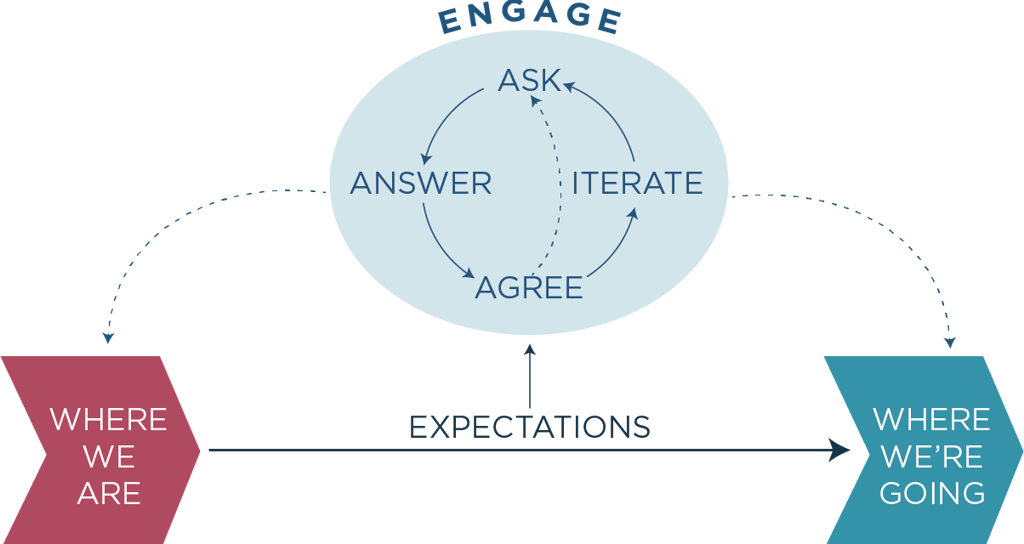Why Can't They Just 3—There’s a Better Way: The Engagement Model
Sarah Kesher


Read the rest of the series here.
In the first two installments, we explored a pattern that shows up for so many well-intentioned leaders: you set high expectations, you give direction (or think you did), and you’re still met with disappointing results.
The work doesn’t land. Or it’s off base. Or it doesn’t happen at all.
And when that becomes the norm, frustration starts to build. Not just with the work—but with the people doing the work. You start to doubt them. They start to doubt themselves. And you begin the slow slide toward micromanagement, over-functioning, or disengagement altogether.
You’re not trying to be a “bad leader.” You’re trying to get things done. But when your team can’t follow through, it’s exhausting.
Meanwhile, on the other side, your team may be feeling confused, deflated, or just plain stuck. They might not understand what’s expected. They might not see why it matters. They might even feel like their contributions don’t count.
So far in this series, we’ve been breaking down that cycle.
Now it’s time to shift gears.
There is a way out of it.
And no, it doesn’t start with “holding people more accountable.”
It starts with how you engage.
So, what do we actually do about it?
Before we get into how to break the cycle, let’s set the stage with a few truths:
1. There’s no magic wand. But there is ownership.
What we’re talking about here isn’t complicated—but it’s not automatic either. It takes effort. It takes repetition. And yes, it takes self-awareness.
If you want to see something different from your team, you have to be willing to look at your own part in how things are working now.
2. It takes time.
These habits—yours and theirs—didn’t develop overnight. Some of the patterns may be years in the making. That’s okay.
Don’t let the time it might take to change them keep you from starting.
3. You don’t have to do it alone.
This isn’t about fixing everything by yourself. While you as an individual leader matter, culture change requires more than one person.
As you start to show up differently, you’ll likely need to bring others along with you—inviting them into this approach, modeling it, and advocating for a shift in how work gets done.
The Engagement Model
Here’s the good news: there is a structure that works.
Over time, in my work with leaders and teams, I’ve found that when we interrupt the high-expectation-to-disappointment cycle, it’s usually because a leader has made some version of three key behavior shifts—whether they realize it or not.
The Engagement Model gives us a simple, practical way to name and repeat those shifts. It’s not a script. It’s not a training program. It’s a new way of thinking about how we communicate, clarify, and lead.
Here’s what it looks like at a high level:


© 2025 Sarah Kesher Consulting. All rights reserved.
The Foundation: Clarity + Meaning
It’s not enough to tell someone what to do. They need to know why it matters.
When people understand the current state, the goal, and their role in getting there, they’re far more likely to take ownership—not just of the task, but of the outcome.Ask to Engage
Once direction is set, most leaders default to outlining the task and stepping back—or stepping in when things go off track.
But the shift we’re making here is different.
Instead of assigning the work outright, we start by asking.
How would they approach it?
What’s their plan?
What support or resources do they need?This isn’t just a nice-to-have moment of inclusion.
It’s a powerful way to create clarity, ownership, and alignment—before a single task is handed over.When we stay curious, ask thoughtful questions, and co-create a starting point, we’re not just transferring work—we’re sharing responsibility.
Asking first is what keeps them in the driver’s seat—and keeps us out of the weeds.
The Feedback Loop
This isn’t about formal review sessions or “tough conversations.”
It’s about making feedback feel like a normal part of how we work together.
Frequent, low-stakes input (and acknowledgment) keeps things from going off course—and builds trust instead of fear.
We’ll get into all three.
But let’s start with the first: The Foundation.
This is where we lay the groundwork for alignment, motivation, and accountability.
The Foundation: Connect to the Why
When work misses the mark, the instinct is often to assume someone didn’t listen. Or didn’t care.
But more often than not, they didn’t fully understand what was expected—or why it mattered in the first place.
They didn’t have enough context to make good decisions.
They couldn’t fill in the gaps in your instructions.
They didn’t see how their part fit into the whole.
And that’s not on them alone.
That’s on the Foundation.
Here’s the structure I use with leaders and clients.
And let me be clear—this isn’t new. You’ve probably heard a version of it before.
What makes it different is how it fits within the larger model:
Where We Are (Current State)
Describe what’s happening right now.
What’s the situation—and why isn’t it working?Focus on the impact, ideally on people your team member cares about (clients, colleagues, end users). This applies to both product and service examples.
There has to be some reason we’re making something new or changing something existing.
Where We’re Going (Desired State)
Paint a picture of what good looks like.
What’s the goal? What does success mean here?Who benefits when we get this right? What’s the value of the new—or new and improved—result?
How We’re Getting There (Expectations)
What do you want this person to do?
This is where the temptation kicks in—to go into all the details of the tasks and deliverables. But now is not the time. That’s coming. Right now, we are still painting the bigger picture.
This is about the role you need them to play, and the responsibilities they hold for moving the work forward.
This doesn’t need to be a long conversation. A few thoughtful sentences for each point is plenty.
And you don’t need to go in order—but don’t bounce around.
Cover each point once, clearly.
In fact, one of the most effective formats is:
“Here’s where we are, here’s where we’re going, and here’s what I need from you to help us get there.”
Here’s what that might sound like in practice:
“Elizabeth at ABC Company brought us in because their order fulfillment process is slow and clunky. Her team is struggling to keep up, and the frustration is starting to damage morale. On top of that, the extra time is leading to extra costs—costs that are passed on to clients, who are beginning to walk away.”
“They’re looking for a solution that speeds up the process and is easier to use—without requiring a complete overhaul of their tech stack. I know you’ve worked with Elizabeth before, and we really want to help her team and the company get this right.”
“I’d like you to lead the discovery phase. That means mapping the current process, talking with the people who use it every day, and pulling together a few quick-win changes we can prototype. Keep both me and Elizabeth in the loop as you go. You’ve got the right blend of systems thinking and people skills to lead this well.”
That’s it. It’s clear. It’s purposeful.
And it gives the team member something to take ownership of—not just a task, but a result.
Even more importantly, it creates a reference point you can return to if things go sideways.
You’re not nitpicking—you’re guiding back to the shared understanding you created at the start.
Up Next: Ask to Engage
Next time, we’ll dig into the second part of the model—how asking better questions can increase ownership and decrease rework.
But for now, try the Foundation.
Choose one upcoming conversation and try structuring it this way. See what shifts.
If you missed the earlier installments, you can catch up here.
“We’re not just transferring work—we’re sharing responsibility.”
"Now it's time to shift gears.
There is a way out."




